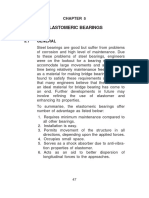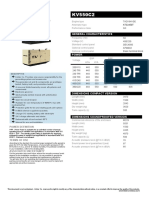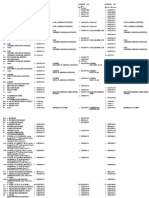Clamp Fixing
Uploaded by
Stefan JakovljevicClamp Fixing
Uploaded by
Stefan JakovljevicConstruction details
Clamp fixing
3.1.25 Glass suspended with clamping plates 2
Vertical section and elevation 2
scale 1:5
3
3
For frameless glazing it is often more sensible
to design the glass as a suspended system
(curtain wall) – instead of supporting it from
underneath – to rule out stability problems. 5 4
4
However, this can be achieved only by using
elaborate and expensive connections. The
clamp fixing shown here was specifically 1
devised for fixing single glazing. A screw
mechanism transfers the clamping force into
the pane of glass, which can accommodate the
weight of the glass, depending on the coeffi- pads and environmental conditions (moisture,
cient of friction of the intermediate pad temperature, soiling etc.) must be taken into
between glass and clamping jaws. In principle, consideration. Fig. 3.1.35 shows an even and
clamp fixings are a suitable means of jointing statically determinate load transfer through an 1 Glass 6
for glass because in contrast to point fixings, articulated joint and correspondingly long 2 Articulated joint
the loads can be transferred evenly into the clamping pieces. The bottom edges of the 3 Clamping section
glass and essentially avoid any concentrations panes must remain free to move. They are 4 Clamping jaws
5 Intermediate pad
of stress. On the practical side, boundary con- therefore sealed in grooved gaskets in such a as friction surface
ditions such as the surface finish of the friction way that structural movement or deflections in 6 Permanently elastic
faces, the creep characteristics of intermediate the floor slab can be compensated for. joint
3.1.25
Bearing fixing
3.1.26 Rigid connection via bearing in drilled
hole
3.1.27 Glass fin
Elevations and horizontal sections
scale 1:5
Bearing fixings have proved useful in steel and
timber engineering. They are characterized by 2 1 2
their simple and robust handling, which makes
them ideal for the conditions on a building site. 3
However, in the case of glass, in contrast to
structural steelwork, we cannot assume a uni-
form distribution of the bearing pressure on the 1
sides of the hole. In order to distribute the pres- 1 4
sure as evenly as possible over the sides of a
hole drilled through glass, a bush must be
inserted between bolt and glass to dissipate
the stress peaks. The bushes are made from
special aluminium alloys or synthetic materials
(Teflon, polyamide), or are injected materials
such as epoxy, polyester or polyurethane, and
must be durable, able to withstand the rigours
of the weather. The long-term suitability of bush 5 6 3.1.26
materials must be verified beforehand by way resulting properties must be taken into account
of tests. No relative movements between the when calculating the stresses in the glass, and 1 Glass 4 6
glass elements can be permitted in connec- if an expansion joint is required, it must be 2 Bolt with locknut
tions designed to transfer forces. The bolted incorporated at another place, not here. In the 3 Steel splice plate
4 Intermediate pad
connections shown in figs 3.1.26 and 3.1.27 case of laminated glass and laminated safety 5 Washer
function as though the individual glass compo- glass, the flow properties of the interlayer must 6 Sleeve made from
nents were one piece. This is a rigid joint. The be taken into account. injected material
3.1.27
169
You might also like
- Installation Manual VRV S RMXYQ AVL PDFNo ratings yetInstallation Manual VRV S RMXYQ AVL PDF36 pages
- Course Specification of Automotive EngineeringNo ratings yetCourse Specification of Automotive Engineering16 pages
- Determining Load Resistance of Glass in Buildings: Standard Practice ForNo ratings yetDetermining Load Resistance of Glass in Buildings: Standard Practice For1 page
- E 1300-09a - Standard Practice For Determining Load Resistance of Glass in BuildingsNo ratings yetE 1300-09a - Standard Practice For Determining Load Resistance of Glass in Buildings61 pages
- Standard Practice For Determining Load Resistance of Glass in BuildingsNo ratings yetStandard Practice For Determining Load Resistance of Glass in Buildings62 pages
- ACI 224.3R-95 Joints in Concrete Slabon Grade[1]No ratings yetACI 224.3R-95 Joints in Concrete Slabon Grade[1]5 pages
- E1300-12A Standard Practice For Determining Load Resistance of Glass in BldgsNo ratings yetE1300-12A Standard Practice For Determining Load Resistance of Glass in Bldgs59 pages
- Composite Materials Note Form Nptel in PDF100% (1)Composite Materials Note Form Nptel in PDF33 pages
- Science and Engineering of Glass and Natural Stone in ConstructionNo ratings yetScience and Engineering of Glass and Natural Stone in Construction32 pages
- Determination of Bending Tensile Strength of Thin GlassNo ratings yetDetermination of Bending Tensile Strength of Thin Glass10 pages
- Effect of Residual Stresses in Float-Glass On Cutting QualityNo ratings yetEffect of Residual Stresses in Float-Glass On Cutting Quality4 pages
- Discussion-For Loads Having Durations Other Than 3 S: Table X4.1No ratings yetDiscussion-For Loads Having Durations Other Than 3 S: Table X4.11 page
- Dokumen - Tips - Design Guidelines For Ply Drop Off in Laminated Composite Guidelines For PlyNo ratings yetDokumen - Tips - Design Guidelines For Ply Drop Off in Laminated Composite Guidelines For Ply12 pages
- Evaluating Flat-Faced Gasketed Joint Assemblies: Standard Practice ForNo ratings yetEvaluating Flat-Faced Gasketed Joint Assemblies: Standard Practice For3 pages
- 2005 GPD2005 PlateBuckling 18-07LuibleAndreascorrectedNo ratings yet2005 GPD2005 PlateBuckling 18-07LuibleAndreascorrected5 pages
- Evaluating Flat-Faced Gasketed Joint Assemblies: Standard Practice ForNo ratings yetEvaluating Flat-Faced Gasketed Joint Assemblies: Standard Practice For3 pages
- Simulation and Validation of Glass Railing System Using Structural Analysis On ANSYSNo ratings yetSimulation and Validation of Glass Railing System Using Structural Analysis On ANSYS6 pages
- Capacity Design of Infilled Frame Structures: Francisco J CRISAFULLI, Athol J CARR and Robert PARKNo ratings yetCapacity Design of Infilled Frame Structures: Francisco J CRISAFULLI, Athol J CARR and Robert PARK8 pages
- Glass Structures - Learning From Experts: D. Honfi M. OverendNo ratings yetGlass Structures - Learning From Experts: D. Honfi M. Overend9 pages
- Guide To Installation of Steel Windows: Sealing The JointNo ratings yetGuide To Installation of Steel Windows: Sealing The Joint6 pages
- Concrete Construction Article PDF_ Controlling Cracking in Precast ProductsNo ratings yetConcrete Construction Article PDF_ Controlling Cracking in Precast Products3 pages
- Standard - ITA-No7-Avril-2016 - Annex 02 - Cracks-Concrete ConstructionNo ratings yetStandard - ITA-No7-Avril-2016 - Annex 02 - Cracks-Concrete Construction7 pages
- Flexible Glass: Enabling Thin, Lightweight, and Flexible ElectronicsFrom EverandFlexible Glass: Enabling Thin, Lightweight, and Flexible ElectronicsSean M. GarnerNo ratings yet
- Facades: 8 8 V V V 2 22 V V V 1 11 V V V 4 44 V V V 3 33No ratings yetFacades: 8 8 V V V 2 22 V V V 1 11 V V V 4 44 V V V 3 331 page
- 1.4 The Social, Cognitive and Experiential: 1.3 The Signi Ficance of Space 11No ratings yet1.4 The Social, Cognitive and Experiential: 1.3 The Signi Ficance of Space 111 page
- 34 Becker Architekten Hydroelectric Power Station Kempten, GermanyNo ratings yet34 Becker Architekten Hydroelectric Power Station Kempten, Germany1 page
- Tsukuba, J 1994 Architects: Naito Architects & Ass., Tokyo Hiroshi Naito, Tatsuo Yoshida º Detail 4/1996No ratings yetTsukuba, J 1994 Architects: Naito Architects & Ass., Tokyo Hiroshi Naito, Tatsuo Yoshida º Detail 4/19961 page
- Residence and Studio at Gallina Canyon, New Mexico, USA: Built Examples 162No ratings yetResidence and Studio at Gallina Canyon, New Mexico, USA: Built Examples 1621 page
- Timber Construction Systems: Materials - ModulesNo ratings yetTimber Construction Systems: Materials - Modules1 page
- Adhesives For Glass Construction: Eaves Details For Sloping GlazingNo ratings yetAdhesives For Glass Construction: Eaves Details For Sloping Glazing1 page
- 36 Claus en Kaan Architecten Crematorium Heimolen Sint-Niklaas, BelgiumNo ratings yet36 Claus en Kaan Architecten Crematorium Heimolen Sint-Niklaas, Belgium1 page
- Designing With Glass - Strength and Loadbearing BehaviourNo ratings yetDesigning With Glass - Strength and Loadbearing Behaviour1 page
- 35 Bennetts Associates Mint Hotel Tower of London City of London, UKNo ratings yet35 Bennetts Associates Mint Hotel Tower of London City of London, UK1 page
- 3.3 Architectural Details Flat Roof JunctionNo ratings yet3.3 Architectural Details Flat Roof Junction1 page
- Cleaning and Maintenance Influence On Functional DataNo ratings yetCleaning and Maintenance Influence On Functional Data1 page
- Panorama Gallery, Mt. Pilatus: Unauthenticated Download Date - 3/25/16 9:34 AMNo ratings yetPanorama Gallery, Mt. Pilatus: Unauthenticated Download Date - 3/25/16 9:34 AM1 page
- Set Timing Engine - Mechanical - 5s-Fe-2No ratings yetSet Timing Engine - Mechanical - 5s-Fe-22 pages
- Applied Thermal Engineering: Unit - 1: Steam GeneratorsNo ratings yetApplied Thermal Engineering: Unit - 1: Steam Generators30 pages
- Electrical Power Generator Inspection CheklistNo ratings yetElectrical Power Generator Inspection Cheklist1 page
- Cold and Hot Water Demand Calculation Alfouzan100% (1)Cold and Hot Water Demand Calculation Alfouzan22 pages
- FPT-IVECO-USE-AND-MAINTENANCE-CURSOR-SERIESNo ratings yetFPT-IVECO-USE-AND-MAINTENANCE-CURSOR-SERIES25 pages
- Failure and Sensitivity Analysis of A Reconfigurable Vibrating Screen Using Finite Element AnalysisNo ratings yetFailure and Sensitivity Analysis of A Reconfigurable Vibrating Screen Using Finite Element Analysis12 pages















































































































